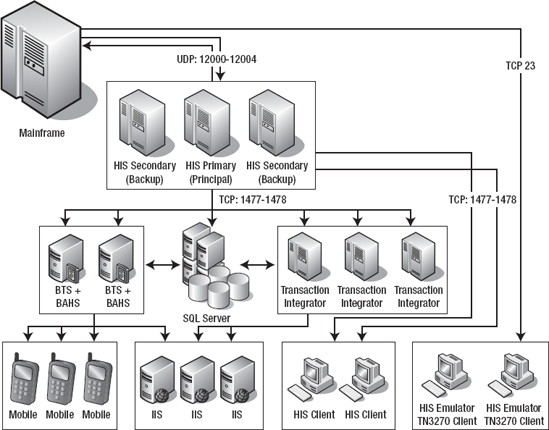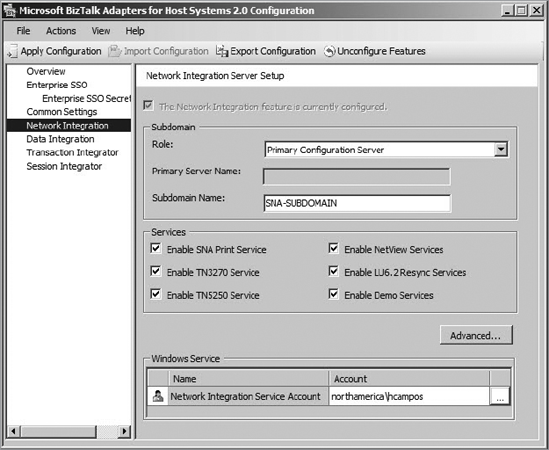In this section, we will discuss some Host Integration Server topologies based on different application integration scenarios. Topologies are component arrangements that help you model and organize your solutions. Figure 1 shows a sample architecture of a legacy integration solution at a high level.

1. Setup Considerations
Host Integration Server
is organized into subdomains. That gives the capacity of sharing
resources between nodes. Actually, when HIS clients try to connect to an
HIS server (a sponsor server), they are contacting the entire Host
Integration Server subdomain.
Host Integration
Server SNA Gateway services store configuration information in a file
called COM.cfg. This file is shared across all the servers in the Host
Integration Server subdomain. Although we will address service accounts, our first recommendation is to make sure the
service account that Host Integration Server will use is a valid Windows
domain account and member of the Host Integration Server runtime users
group of every HIS server.
Host Integration
Server provides host connectivity by centralizing the responsibility for
the node and physical connectivity at the server level, while still
allowing the client to access the full SNA protocol stack. This
configuration releases resources from the client by not having the
client accessing the host but instead having the client connected to the
Host Integration Server. The connection from the client to the Host
Integration Server uses standard LAN protocols and uses one of two
modes: sponsor connections or Active Directory. With sponsor
connections, the connection is direct from the Host Integration Server
client to the server, whereas with Active Directory connections, the
Host Integration Server client should locate an Active Directory server
first to run LDAP queries to retrieve the information that needs to
populate its service table.
To decide on either one
discovery mechanism or another, you have to find out whether the
customer is interested in having a Host Integration Server
organizational unit and also verify that its Active Directory network
communications will be strong enough to handle the additional load
successfully. Otherwise, we recommend using sponsor connections.
Host Integration
Server client-server communication requires ports 1477 and 1478 to be
open between the client and the server. HIS 2009 creates rules in
Windows Firewall for those ports, so if your servers have Windows
Firewall enabled, then you will just have to enable the Host Integration
Server exception. Keep this in mind when setting up your solution.
During the HIS setup process, you will be asked to complete information
depending on the topology selected.
From a software perspective,
HIS has two setup modes: server and client. Server components include
the BizTalk Adapter for Host Systems, Transaction Integrator, Session
Integrator, Enterprise Single Sign-On, and SNA Gateway. Client
components include client libraries, the Enterprise Single Sign-On
client, and the 3270 and 5250 terminal emulators. There are a couple
more options available to install: Development and Documentation. The
first one provides the set of project templates and libraries needed to
create HIS projects in development environments using Visual Studio
2008, whereas the latter is the product documentation component that, in
our opinion, should never be missed in any HIS installation.
Host Integration Server
can also be installed and configured in unattended mode using the Setup
and Configuration commands. Please refer to the readme file on the Host
Integration Server 2009 media to learn more about these commands.
2. Host Integration Server Topologies
From a topology perspective, now
that you are familiar with the HIS client-server concept, we'll cover
the server topologies. The determining factors of the server topologies
in HIS are the SNA Gateway services. If they are available in the
server, then it means that they can provide mainframe connectivity
services and also can act as sponsor servers of other HIS servers. A sponsor server
is a server that provides the HIS clients with information about the
resources available in the HIS subdomain. Nevertheless, if an HIS server
does not provide SNA Gateway services, then the HIS server will require
an additional server that does. The type of server that does not
include SNA Gateway services is called a nodeless server, because it will route its SNA application requests to a sponsor server.
In distributed environments, like
the one I will present shortly, Transaction Integrator is usually installed as a nodeless server. This
configuration allows the creation of isolated layers for the application
servers and the SNA Gateway servers. It is of the utmost importance to
have the SNA Gateway servers isolated in a dedicated layer, because the
SNA Gateway servers will likely provide many legacy integration services
for the entire organization such as application integration, host
printing sessions, and terminal emulation.
Figure 2
shows the configuration screen under the Network Integration option for
a SNA Gateway mode install. In the Role drop-down list, you can change
the role to Secondary Configuration Server, if you want the server to be
one of the allowable backup servers in the Host Integration Server
subdomain. Remember that the Host Integration Server subdomain is not a
Windows domain but requires a Windows domain to exist.
